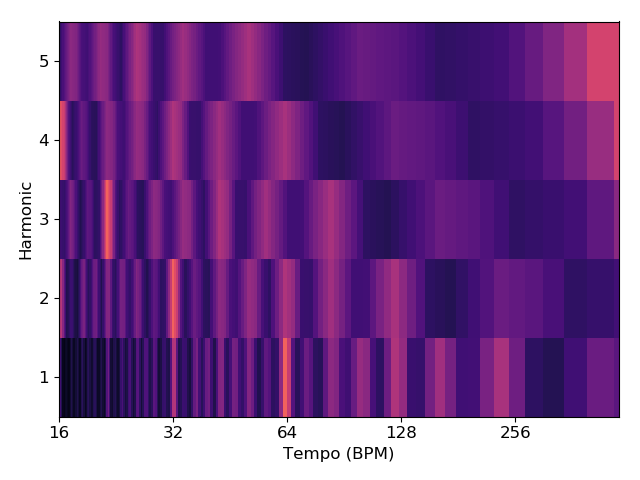librosa.core.interp_harmonics¶
-
librosa.core.interp_harmonics(x, freqs, h_range, kind=’linear’, fill_value=0, axis=0)[source]¶ Compute the energy at harmonics of time-frequency representation.
Given a frequency-based energy representation such as a spectrogram or tempogram, this function computes the energy at the chosen harmonics of the frequency axis. (See examples below.) The resulting harmonic array can then be used as input to a salience computation.
Parameters: - x : np.ndarray
The input energy
- freqs : np.ndarray, shape=(X.shape[axis])
The frequency values corresponding to X’s elements along the chosen axis.
- h_range : list-like, non-negative
Harmonics to compute. The first harmonic (1) corresponds to x itself. Values less than one (e.g., 1/2) correspond to sub-harmonics.
- kind : str
Interpolation type. See
scipy.interpolate.interp1d.- fill_value : float
The value to fill when extrapolating beyond the observed frequency range.
- axis : int
The axis along which to compute harmonics
Returns: - x_harm : np.ndarray, shape=(len(h_range), [x.shape])
x_harm[i] will have the same shape as x, and measure the energy at the h_range[i] harmonic of each frequency.
See also
Examples
Estimate the harmonics of a time-averaged tempogram
>>> y, sr = librosa.load(librosa.util.example_audio_file(), ... duration=15, offset=30) >>> # Compute the time-varying tempogram and average over time >>> tempi = np.mean(librosa.feature.tempogram(y=y, sr=sr), axis=1) >>> # We'll measure the first five harmonics >>> h_range = [1, 2, 3, 4, 5] >>> f_tempo = librosa.tempo_frequencies(len(tempi), sr=sr) >>> # Build the harmonic tensor >>> t_harmonics = librosa.interp_harmonics(tempi, f_tempo, h_range) >>> print(t_harmonics.shape) (5, 384)
>>> # And plot the results >>> import matplotlib.pyplot as plt >>> plt.figure() >>> librosa.display.specshow(t_harmonics, x_axis='tempo', sr=sr) >>> plt.yticks(0.5 + np.arange(len(h_range)), ... ['{:.3g}'.format(_) for _ in h_range]) >>> plt.ylabel('Harmonic') >>> plt.xlabel('Tempo (BPM)') >>> plt.tight_layout()
We can also compute frequency harmonics for spectrograms. To calculate sub-harmonic energy, use values < 1.
>>> h_range = [1./3, 1./2, 1, 2, 3, 4] >>> S = np.abs(librosa.stft(y)) >>> fft_freqs = librosa.fft_frequencies(sr=sr) >>> S_harm = librosa.interp_harmonics(S, fft_freqs, h_range, axis=0) >>> print(S_harm.shape) (6, 1025, 646)
>>> plt.figure() >>> for i, _sh in enumerate(S_harm, 1): ... plt.subplot(3, 2, i) ... librosa.display.specshow(librosa.amplitude_to_db(_sh, ... ref=S.max()), ... sr=sr, y_axis='log') ... plt.title('h={:.3g}'.format(h_range[i-1])) ... plt.yticks([]) >>> plt.tight_layout()

